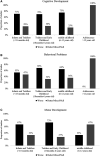Prenatal exposure to opioids and neurodevelopment in infancy and childhood: A systematic review
- PMID: 36896405
- PMCID: PMC9989202
- DOI: 10.3389/fped.2023.1071889
Prenatal exposure to opioids and neurodevelopment in infancy and childhood: A systematic review
Abstract
Aim: This systematic review aims to estimate the relationship between prenatal exposure to opioids and neurodevelopmental outcomes and examines potential sources of heterogeneity between the studies.
Methods: We searched four databases through May 21st, 2022: PubMed, Embase, PsycInfo and the Web of Science according to a specified search strings. Study inclusion criteria include: (1) cohort and case-control peer-reviewed studies published in English; (2) studies comparing neurodevelopmental outcomes among children with prenatal opioid-exposure (prescribed or used non-medically) vs. an unexposed group. Studies investigating fetal alcohol syndrome or a different primary prenatal exposure other than opioids were excluded. Two main performed data extraction using "Covidence" systematic review platform. This systematic review was conducted in accordance with PRISMA guidelines. The Newcastle-Ottawa-Scale was used for quality assessment of the studies. Studies were synthesized based on the type of neurodevelopmental outcome and the instrument used to assess neurodevelopment.
Results: Data were extracted from 79 studies. We found significant heterogeneity between studies due to their use of different instruments to explore cognitive skills, motor, and behavioral outcomes among children of different ages. The other sources of heterogeneity included: procedures to assess prenatal exposure to opioids; period of pregnancy in which exposure was assessed; type of opioids assessed (non-medical, medication used for opioid use dis-order, prescribed by health professional), types of co-exposure; source of selection of prenatally exposed study participants and comparison groups; and methods to address lack of comparability between exposed and unexposed groups. Cognitive and motor skills as well as behavior were generally negatively affected by prenatal opioid exposure, but the significant heterogeneity precluded a meta-analysis.
Conclusion: We explored sources of heterogeneity in the studies assessing the association between prenatal exposure to opioids and neurodevelopmental outcomes. Sources of heterogeneity included different approaches to participant recruitment as well as exposure and outcome ascertainment methods. Nonetheless, overall negative trends were observed between prenatal opioid exposure and neuro-developmental outcomes.
Keywords: in utero exposure; neurodevelopment; opioid-Related disorders; opioids; prenatal exposure delayed effects.
© 2023 Balalian, Graeve, Richter, Fink, Kielstein, Martins, Philbin and Factor-Litvak.
Conflict of interest statement
The authors declare that the research was conducted in the absence of any commercial or financial relationships that could be construed as a potential conflict of interest.
Figures



Similar articles
-
Beyond the black stump: rapid reviews of health research issues affecting regional, rural and remote Australia.Med J Aust. 2020 Dec;213 Suppl 11:S3-S32.e1. doi: 10.5694/mja2.50881. Med J Aust. 2020. PMID: 33314144
-
Cognitive Outcomes of Young Children After Prenatal Exposure to Medications for Opioid Use Disorder: A Systematic Review and Meta-analysis.JAMA Netw Open. 2020 Mar 2;3(3):e201195. doi: 10.1001/jamanetworkopen.2020.1195. JAMA Netw Open. 2020. PMID: 32186745 Free PMC article.
-
Neurodevelopmental Outcomes of Children Born to Opioid-Dependent Mothers: A Systematic Review and Meta-Analysis.Acad Pediatr. 2020 Apr;20(3):308-318. doi: 10.1016/j.acap.2019.11.005. Epub 2019 Nov 14. Acad Pediatr. 2020. PMID: 31734383
-
Low to Moderate Prenatal Alcohol Exposure and Neurodevelopmental Outcomes: A Narrative Review and Methodological Considerations.Alcohol Res. 2023 Mar 16;43(1):01. doi: 10.35946/arcr.v43.1.01. eCollection 2023. Alcohol Res. 2023. PMID: 36950180 Free PMC article. Review.
-
Cognitive and Motor Outcomes of Children With Prenatal Opioid Exposure: A Systematic Review and Meta-analysis.JAMA Netw Open. 2019 Jul 3;2(7):e197025. doi: 10.1001/jamanetworkopen.2019.7025. JAMA Netw Open. 2019. PMID: 31298718 Free PMC article.
Cited by
-
Prophylactic red cell transfusions for sickle cell disease pregnancy: increased use of therapy could transform outcomes.Curr Opin Hematol. 2024 Nov 1;31(6):285-293. doi: 10.1097/MOH.0000000000000837. Epub 2024 Aug 22. Curr Opin Hematol. 2024. PMID: 39177058 Review.
-
The Association Between In Utero Exposure to Painkillers and Trajectories of Hyperactivity and Emotional Problems in Children with Autism Compared with Neurotypical Peers.Children (Basel). 2024 Dec 23;11(12):1558. doi: 10.3390/children11121558. Children (Basel). 2024. PMID: 39767987 Free PMC article.
-
Prenatal Opioid Exposure and Risk for Adverse Brain and Motor Outcomes in Infants Born Premature.J Pediatr. 2024 Apr;267:113908. doi: 10.1016/j.jpeds.2024.113908. Epub 2024 Jan 12. J Pediatr. 2024. PMID: 38220065 Free PMC article.
-
Seafood During Pregnancy and Lactation and Child Neurocognitive Development: A Systematic Review.Adv Nutr. 2025 May;16(5):100414. doi: 10.1016/j.advnut.2025.100414. Epub 2025 Apr 25. Adv Nutr. 2025. PMID: 40374262 Free PMC article.
-
Illicit substance exposure in pregnancy and infant mortality risk: a nationwide Taiwan study.Int J Neuropsychopharmacol. 2025 Aug 1;28(8):pyaf046. doi: 10.1093/ijnp/pyaf046. Int J Neuropsychopharmacol. 2025. PMID: 40632100 Free PMC article.
References
-
- United Nations Office on Drugs and Crime. World Drug Report (2022).
-
- Lesser JG, Pope DS. Early childhood the toddler and early school years. In: Dodge A, editor. Human behavior and the social environment: Theory and practice. Boston, MA: Pearson Allyn & Bacon; (2007). p. 264–70.
Publication types
Grants and funding
LinkOut - more resources
Full Text Sources

